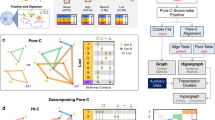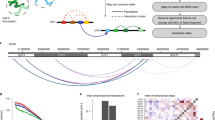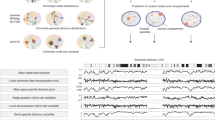Abstract
The genome forms extensive and dynamic physical interactions with itself in the form of chromosome loops and bridges, thus exploring the three-dimensional space of the nucleus. It is now possible to examine these interactions at the molecular level, and we have gained glimpses of their functional implications. Chromosomal interactions can contribute to the silencing and activation of genes within the three-dimensional context of the nuclear architecture. Technical advances in detecting these interactions contribute to our understanding of the functional organization of the genome, as well as its adaptive plasticity in response to environmental changes during development and disease.
This is a preview of subscription content, access via your institution
Access options
Subscribe to this journal
Receive 51 print issues and online access
$199.00 per year
only $3.90 per issue
Buy this article
- Purchase on Springer Link
- Instant access to full article PDF
Prices may be subject to local taxes which are calculated during checkout




Similar content being viewed by others
References
Wilson, E. The Cell in Development and Heredity (Macmillan, 1928).
Duncan, I. W. Transvection effects in Drosophila . Annu. Rev. Genet. 36, 521–556 (2002).
Cook, P. R. The organization of replication and transcription. Science 284, 1790–1795 (1999).
Misteli, T. Nuclear order out of chaos. Nature 456, 333–334 (2008).
Kaiser, T. E., Intine, R. V. & Dundr, M. De novo formation of a subnuclear body. Science 322, 1713–1717 (2008).
McStay, B. & Grummt, I. The epigenetics of rRNA genes: from molecular to chromosome biology. Annu. Rev. Cell Dev. Biol. 24, 131–157 (2008).
Lanctot, C., Cheutin, T., Cremer, M., Cavalli, G. & Cremer, T. Dynamic genome architecture in the nuclear space: regulation of gene expression in three dimensions. Nature Rev. Genet. 8, 104–115 (2007).
Guelen, L. et al. Domain organization of human chromosomes revealed by mapping of nuclear lamina interactions. Nature 453, 948–951 (2008).
Osborne, C. S. et al. Active genes dynamically colocalize to shared sites of ongoing transcription. Nature Genet. 36, 1065–1071 (2004).
Jackson, D. A., Hassan, A. B., Errington, R. J. & Cook, P. R. Visualization of focal sites of transcription within human nuclei. EMBO J. 12, 1059–1065 (1993).
Faro-Trindade, I. & Cook, P. R. Transcription factories: structures conserved during differentiation and evolution. Biochem. Soc. Trans. 34, 1133–1137 (2006).
Fraser, P. & Bickmore, W. Nuclear organization of the genome and the potential for gene regulation. Nature 447, 413–417 (2007).
Hassan, A. B. & Cook, P. R. Visualization of replication sites in unfixed human cells. J. Cell Sci. 105, 541–550 (1993).
Chakalova, L., Debrand, E., Mitchell, J. A., Osborne, C. S. & Fraser, P. Replication and transcription: shaping the landscape of the genome. Nature Rev. Genet. 6, 669–677 (2005).
Göndör, A. & Ohlsson, R. Replication timing and epigenetic reprogramming of gene expression: a two-way relationship? Nature Rev. Genet. 10, 269–276 (2009).
Soutoglou, E. & Misteli, T. Mobility and immobility of chromatin in transcription and genome stability. Curr. Opin. Genet. Dev. 17, 435–442 (2007).
Dostie, J. et al. Chromosome conformation capture carbon copy (5C): a massively parallel solution for mapping interactions between genomic elements. Genome Res. 16, 1299–1309 (2006).
Rippe, K. Making contacts on a nucleic acid polymer. Trends Biochem. Sci. 26, 733–740 (2001).
Li, Q., Barkess, G. & Qian, H. Chromatin looping and the probability of transcription. Trends Genet. 22, 197–202 (2006).
Ishihara, K., Oshimura, M. & Nakao, M. CTCF-dependent chromatin insulator is linked to epigenetic remodeling. Mol. Cell 23, 733–742 (2006).
Cremer, T. & Cremer, C. Rise, fall and resurrection of chromosome territories: a historical perspective. Part II. Fall and resurrection of chromosome territories during the 1950s to 1980s. Part III. Chromosome territories and the functional nuclear architecture: experiments and models from the 1990s to the present. Eur. J. Histochem. 50, 223–272 (2006).
Hu, Q. et al. Enhancing nuclear receptor-induced transcription requires nuclear motor and LSD1-dependent gene networking in interchromatin granules. Proc. Natl Acad. Sci. USA 105, 19199–19204 (2008). This report demonstrates that chromatin crosstalk involves directed rapid movement of interacting loci and that this process is frequently accompanied by reorganization of the chromosome territories.
Apostolou, E. & Thanos, D. Virus infection induces NF-κB-dependent interchromosomal associations mediating monoallelic IFN-β gene expression. Cell 134, 85–96 (2008). This report shows that the organization of the IFNB enhanceosome requires the juxtaposition of one or more sequences from other chromosomes that contain NF-κB-bound Alu repeats.
Walter, J., Hutter, B., Khare, T. & Paulsen, M. Repetitive elements in imprinted genes. Cytogenet. Genome Res. 113, 109–115 (2006).
Zhao, Z. et al. Circular chromosome conformation capture (4C) uncovers extensive networks of epigenetically regulated intra- and interchromosomal interactions. Nature Genet. 38, 1341–1347 (2006).
Bartlett, J. et al. Specialized transcription factories. Biochem. Soc. Symp. 73, 67–75 (2006).
Xu, M. & Cook, P. R. Similar active genes cluster in specialized transcription factories. J. Cell Biol. 181, 615–623 (2008).
Cai, S., Lee, C. C. & Kohwi-Shigematsu, T. SATB1 packages densely looped, transcriptionally active chromatin for coordinated expression of cytokine genes. Nature Genet. 38, 1278–1288 (2006).
Vernimmen, D., De Gobbi, M., Sloane-Stanley, J. A., Wood, W. G. & Higgs, D. R. Long-range chromosomal interactions regulate the timing of the transition between poised and active gene expression. EMBO J. 26, 2041–2051 (2007).
Tsytsykova, A. V. et al. Activation-dependent intrachromosomal interactions formed by the TNF gene promoter and two distal enhancers. Proc. Natl Acad. Sci. USA 104, 16850–16855 (2007).
Deschenes, J., Bourdeau, V., White, J. H. & Mader, S. Regulation of GREB1 transcription by estrogen receptor α through a multipartite enhancer spread over 20 kb of upstream flanking sequences. J. Biol. Chem. 282, 17335–17339 (2007).
Nemeth, A., Guibert, S., Tiwari, V. K., Ohlsson, R. & Langst, G. Epigenetic regulation of TTF-I-mediated promoter–terminator interactions of rRNA genes. EMBO J. 27, 1255–1265 (2008).
Bushey, A. M., Dorman, E. R. & Corces, V. G. Chromatin insulators: regulatory mechanisms and epigenetic inheritance. Mol. Cell 32, 1–9 (2008).
Ohlsson, R., Renkawitz, R. & Lobanenkov, V. CTCF is a uniquely versatile transcription regulator linked to epigenetics and disease. Trends Genet. 17, 520–527 (2001).
Kim, J. H. et al. Human gamma-satellite DNA maintains open chromatin structure and protects a transgene from epigenetic silencing. Genome Res. 19, 533–544 (2009).
Kim, T. H. et al. Analysis of the vertebrate insulator protein CTCF-binding sites in the human genome. Cell 128, 1231–1245 (2007).
Yusufzai, T. M., Tagami, H., Nakatani, Y. & Felsenfeld, G. CTCF tethers an insulator to subnuclear sites, suggesting shared insulator mechanisms across species. Mol. Cell 13, 291–298 (2004).
Dekker, J. The three 'C's of chromosome conformation capture: controls, controls, controls. Nature Methods 3, 17–21 (2006).
Splinter, E. et al. CTCF mediates long-range chromatin looping and local histone modification in the β-globin locus. Genes Dev. 20, 2349–2354 (2006).
Kurukuti, S. et al. CTCF binding at the H19 imprinting control region mediates maternally inherited higher-order chromatin conformation to restrict enhancer access to Igf2 . Proc. Natl Acad. Sci. USA 103, 10684–10689 (2006).
Li, T. et al. CTCF regulates allelic expression of Igf2 by orchestrating a promoter-polycomb repressive complex 2 intrachromosomal loop. Mol. Cell. Biol. 28, 6473–6482 (2008).
Parelho, V. et al. Cohesins functionally associate with CTCF on mammalian chromosome arms. Cell 132, 422–433 (2008).
Wendt, K. S. et al. Cohesin mediates transcriptional insulation by CCCTC-binding factor. Nature 451, 796–801 (2008).
Stedman, W. et al. Cohesins localize with CTCF at the KSHV latency control region and at cellular c-myc and H19/Igf2 insulators. EMBO J. 27, 654–666 (2008).
Hadjur, S. et al. Cohesins form chromosomal cis-interactions at the developmentally regulated IFNG locus. Nature 460, 410–413 (2009).
Göndör, A. & Ohlsson, R. Chromatin insulators and cohesins. EMBO Rep. 9, 327–329 (2008).
Simonis, M. et al. Nuclear organization of active and inactive chromatin domains uncovered by chromosome conformation capture-on-chip (4C). Nature Genet. 38, 1348–1354 (2006).
Ling, J. Q. et al. CTCF mediates interchromosomal colocalization between Igf2/H19 and Wsb1/Nf1 . Science 312, 269–272 (2006).
Masui, O. & Heard, E. RNA and protein actors in X-chromosome inactivation. Cold Spring Harb. Symp. Quant. Biol. 71, 419–428 (2006).
Xu, N., Donohoe, M. E., Silva, S. S. & Lee, J. T. Evidence that homologous X-chromosome pairing requires transcription and Ctcf protein. Nature Genet. 39, 1390–1396 (2007).
Chaumeil, J., Le Baccon, P., Wutz, A. & Heard, E. A novel role for Xist RNA in the formation of a repressive nuclear compartment into which genes are recruited when silenced. Genes Dev. 20, 2223–2237 (2006).
Zhao, J., Sun, B. K., Erwin, J. A., Song, J. J. & Lee, J. T. Polycomb proteins targeted by a short repeat RNA to the mouse X chromosome. Science 322, 750–756 (2008).
Lanzuolo, C., Roure, V., Dekker, J., Bantignies, F. & Orlando, V. Polycomb response elements mediate the formation of chromosome higher-order structures in the bithorax complex. Nature Cell Biol. 9, 1167–1174 (2007).
Tiwari, V. K. et al. PcG proteins, DNA methylation, and gene repression by chromatin looping. PLoS Biol. 6, e306 (2008).
Garrick, D. et al. The role of the polycomb complex in silencing α-globin gene expression in nonerythroid cells. Blood 112, 3889–3899 (2008).
Brown, J. M. et al. Association between active genes occurs at nuclear speckles and is modulated by chromatin environment. J. Cell Biol. 182, 1083–1097 (2008).
Solovei, I. et al. Nuclear architecture of rod photoreceptor cells adapts to vision in mammalian evolution. Cell 137, 356–368 (2009). This report demonstrates that, contrary to expectations, the nuclear architecture in the rod cells of the eye can undergo dramatic reorganization to adapt to a new function associated with nocturnal mammals.
Richter, K., Nessling, M. & Lichter, P. Macromolecular crowding and its potential impact on nuclear function. Biochim. Biophys. Acta 1783, 2100–2107 (2008).
Shimi, T. et al. The A- and B-type nuclear lamin networks: microdomains involved in chromatin organization and transcription. Genes Dev. 22, 3409–3421 (2008).
Mehta, I. S., Elcock, L. S., Amira, M., Kill, I. R. & Bridger, J. M. Nuclear motors and nuclear structures containing A-type lamins and emerin: is there a functional link? Biochem. Soc. Trans. 36, 1384–1388 (2008).
Spilianakis, C. G., Lalioti, M. D., Town, T., Lee, G. R. & Flavell, R. A. Interchromosomal associations between alternatively expressed loci. Nature 435, 637–645 (2005).
Aladjem, M. I. Replication in context: dynamic regulation of DNA replication patterns in metazoans. Nature Rev. Genet. 8, 588–600 (2007).
Hiratani, I. et al. Global reorganization of replication domains during embryonic stem cell differentiation. PLoS Biol. 6, e245 (2008).
Unneberg, P. & Claverie, J. M. Tentative mapping of transcription-induced interchromosomal interaction using chimeric EST & mRNA data. PLoS ONE 2, e254 (2007).
Ohlsson, R. Widespread monoallelic expression. Science 318, 1077–1078 (2007).
Parada, L. A., McQueen, P. G. & Misteli, T. Tissue-specific spatial organization of genomes. Genome Biol. 5, R44 (2004).
Ghoussaini, M. et al. Multiple loci with different cancer specificities within the 8q24 gene desert. J. Natl Cancer Inst. 100, 962–966 (2008).
Steidl, U. et al. A distal single nucleotide polymorphism alters long-range regulation of the PU.1 gene in acute myeloid leukemia. J. Clin. Invest. 117, 2611–2620 (2007).
Branco, M. R. & Pombo, A. Intermingling of chromosome territories in interphase suggests role in translocations and transcription-dependent associations. PLoS Biol. 4, e138 (2006).
Osborne, C. S. et al. Myc dynamically and preferentially relocates to a transcription factory occupied by Igh . PLoS Biol. 5, e192 (2007).
Acknowledgements
We most gratefully acknowledge I. Solovei, B. Joffe, P. Cook, G. Klein and E. Heard for discussions. This work was supported by the Swedish Science Research Council, the Swedish Cancer Research Foundation, the Swedish Pediatric Cancer Foundation, the Lundberg Foundation, and HEROIC and CHILL (European Union integrated projects).
Author information
Authors and Affiliations
Ethics declarations
Competing interests
The authors declare no competing financial interests.
Additional information
Reprints and permissions information is available at http://www.nature.com/reprints.
Correspondence should be addressed to A.G. (anita.gondor@ki.se) or R.O. (rolf.ohlsson@ki.se).
Rights and permissions
About this article
Cite this article
Göndör, A., Ohlsson, R. Chromosome crosstalk in three dimensions. Nature 461, 212–217 (2009). https://doi.org/10.1038/nature08453
Published:
Issue Date:
DOI: https://doi.org/10.1038/nature08453
This article is cited by
-
Modeling and analysis of Hi-C data by HiSIF identifies characteristic promoter-distal loops
Genome Medicine (2020)
-
Pericentromere clustering in Tradescantia section Rhoeo involves self-associations of AT- and GC-rich heterochromatin fractions, is developmentally regulated, and increases during differentiation
Chromosoma (2020)
-
Spatial organization of chromosome territories in the interphase nucleus of trisomy 21 cells
Chromosoma (2018)
-
HiC‐3DViewer: a new tool to visualize Hi‐C data in 3D space
Quantitative Biology (2017)
-
Computational inference of physical spatial organization of eukaryotic genomes
Quantitative Biology (2016)
Comments
By submitting a comment you agree to abide by our Terms and Community Guidelines. If you find something abusive or that does not comply with our terms or guidelines please flag it as inappropriate.



